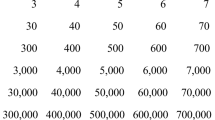Abstract
In this paper we include topics which we consider are relevant building blocks to design a theory of mathematics education. In doing so, we introduce a pretheory consisting of a set of interdisciplinary ideas which lead to an understanding of what occurs in the “central nervous system”—our metaphor for the classroom and eventually in more global settings. In particular we highlight the crucial role of representations, symbols viewed from an evolutionary perspective and mathematics as symbolic technology in which representations are embedded and executable.
Similar content being viewed by others
References
Abramovich and Pieper (1996). Fostering recursive thinking in combinatorics through the use of manipulatives and computer technology.The Mathematics Educator; vol 7, no. 1, pp. 4–12.
Balacheff, N., & Kaput, J. (1996). Computer-based learning environment in mathematics. In A. J. Bishop et al. (Eds.),International handbook of mathematical education (pp. 469–501). Kluwer Academic Publishers, Dordrecht.
Bailey, D. & Borwein, P. (2001),Mathematics Unlimited 2001 and Beyond. B. Engquist and W. Schmid (eds), Springer-Verlag
Batanero, C., & Godino, J. D. (1998). Understanding Graphical and Numerical Representations ff Statistical Association. In: A Computer Environment. V International Conferece on Teaching Statistics, Singapore.
Berger, M. (1998). Graphic calculators: An interpretative framework.For the Learning of Mathematics. 18(2), 13–20.
Bottazzini, U. (1986).The Higher Calculus: A History of Real and Complex analysis from Euler to Weierstrass. New York: Springer Verlag.
Courant, R. & Robbins, H. (2001).Was ist Mathematik? Springer-Verlag.
Dehaene, S. (1997)The Number Sense (Oxford, Univ. Press 1997)
Donald, M. (2001).A Mind so rare. Norton, New York.
Dietrich, O. (2004). Cogntive evolution. in F.M. Wuketits and C. Antweiler (eds).Hanbook, of Evolution (pp. 25–77). Wiley-VCH Verlag GmbH & Co: Weinheim.
Flegg, G. (1983).Numbers: Their history and meaning, Penguin.
Goldin, G. (2004). Problem Solving Heuristics, Affect, and Discrete Mathematics.International Reviews on Mathematical Education, vol 36, no.2, pp. 56–60.
Goldin, G. A. (1998). Representational systems, learning, and problem solving in mathematics.Journal of Mathematical Behavior 17(2), 137–165.
Goldin, G. A., & Kaput, J. J. (1996). A joint perspective on the idea of representation in learning and doing mathematics. In L. Steffe, P. Nesher, P. Cobb, G. A. Goldin, and B. Greer (Eds.),Theories of Mathematical Learning (pp. 397–430). Hillsdale, NJ: Erlbaum.
Goldstein, C. (1999).La naissance du Nombre en Mesopotannie. La Recherche. L'Univers des Nombres thors de serie).
Guin, D. & Trouche, L. (1999). The complex process of converting tools into mathematical instruments: the case of calculators.International Journal of Computers for Mathematical Learning, 3, 195–227.
Hilbert, D. & Cohn-Vossen, S. (1999).Geometry and the Imagination, New York: Chelsea.
Lakatos, I. (1976).Proofs and Refutations. Cambridge University Press.
Manin, Y. I. (1977).A course in mathematical logic, Springer-Verlag, New York.
Moreno, L. A. & Sriraman, B. (2005). Structural stability and dynamic geometry: Some ideas on situated proofs.International Reviews on Mathematical Education, vol. 37, no. 3, pp. 130–139.
Moreno, L.A. & Block, D. (2002)., Democratic Access to Powerful Mathematics in a Developing Country. In L.D. English (ed.)Handbook of International Research in Mathematics Education, (pp. 301~321) Lawrence Erlbaum & Associates.
Joseph, G.G. (1992).The creast of the peacock. Princeton University Press
Maturana, H.R. (1980). Biology of cognition. In Autopoiesis and cognition (pp. 2–62) Boston Studies in the Philosophy of Science. Boston: Reidel.
Miller, Kelly & Zhou, In Handbook of Mathematical Cognition (pp. 163~178)
Noss, R. & Hoyles, C. (1996).Windows on mathematical Meanings Learning Cultures and Computers. Dordrecht: Kluwer Academic Publishers.
Ong, W. (1998).Orality and Literacy, Routledge.
Pimm, D. (1995).Symbols and meanings in school mathematics. London: Routledge.
Peitgen, Jürgen y Saupe (1992).Fractals for the Classroom vol. 1. New York: Springer-Verlag.
Rabardel, P. (1995).Les houmes et les technologies Approache cognitive des instruments contemporains. Paris: Armand Colin.
Relf, S., and Almeida, D. (1999). Exploring the birthdays problem and some of its variants through computer simulationInternational Journal of Mathematical Education with Science and Technology, 30 (1), pp. 81–91.
Schmandt-Besserat, D. (1978). The Earliest Precursor of Writing.Scientific American (pp. 39~47).
Sriraman, B. (2004). Discovering Steiner Triple systems through problem solving.The Mathematics Teacher, vol. 97, no. 5, pp. 320–326.
Author information
Authors and Affiliations
Additional information
This paper is dedicated to Jim Kaput (1942~2005), whose work on representations and technology is an inspiration to us all.




